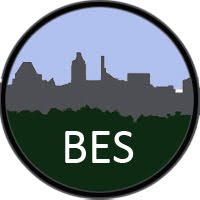Few ideas are as loaded — and as controversial — as that of “weed.” Combine this familiar term with the equally problematic term urban, and surely, confusion is guaranteed to reign.
However Zachary Falck, an environmental historian, acts as a knowledgeable and confident guide into this troubled intellectual territory. He has written the well documented and very readable Weeds: An Environmental History of Metropolitan America, published by the University of Pittsburgh Press in 2010.
My slowness in discovering this book is no indication of its importance. In fact, I recommend it to denizens and friends of the Baltimore Ecosystem Study LTER as a compelling exploration of the interface of the social and the biological through the lens of plants that are themselves vessels of complex connotation.
What’s In A Name?
 |
| Chickory, photo by Erica Tauzer. |
Weeds have many other names, and each name collects its
own bouquet of connotations, biases, and values. This group of plants can be called colonizers, ruderals, and volunteers; invaders, pioneers, or any number of more technical terms. Falck introduces some intentionally novel terms in order to avoid, or perhaps highlight, some of the assumptions so deeply, yet silently, embedded in the term weeds. Perhaps Falck’s primary goal in the book is to make readers look for the hidden social and cultural assumptions that so often accompany the reference to weeds.
One reason I am so impressed with the job Falck does in examining weeds as a window onto urban systems, with both the changes and consistency of the thinking about nature in urban systems, is that my roots as an ecological scientist trace back to studies of the germination behavior of the seeds of common ragweed, Ambrosia artemisiifolia.
These studies, conducted in the lab of Drs. Jerry and Carol Baskin at the University of Kentucky, showed that common ragweed was extraordinarily well adapted to colonizing physically disturbed soils, and its dormant seeds could persist for years buried in the soil between episodes of such disturbance. Yet, the adult plant demands high levels of light and other resources, and as plant communities changed after disturbance, ragweed was displaced by other species that could use lower levels of light and soil resources. Jerry Baskin and I (Pickett and Baskin 1973) concluded that the best management strategy for ragweed was to leave it alone. Soil treatments designed to uproot common ragweed would in fact promote a new crop the next year. Falck reviews the history of ragweed control efforts in some major American cities, and notes their consistent failure. That failure was almost guaranteed by ignorance of the biology of the species and the mismatch between that biology and the management strategies employed. But there are other riches in this book.
Weeds As Social Signifier
Weeds have been addressed as a biological phenomenon, of course, but Falck richly documents how they have also been used as a social signifier. On the one hand, weeds stand for elements, both social and biological, that are deemed suitable for eradication or exclusion from American cities. Hence, disfavored ethnic and racial groups, immigrants from other countries of from rural regions of the US, and persons who engage in what others sometimes or nearly universally define as harmful behaviors, are labeled as weeds. On the other hand, weediness stands for an admirable ability to flourish in polluted, hazardous, or otherwise unfavorable conditions. This description has been applied to plants, animals, and, again, to different social groups.
The troubling thing about all these assumptions is that they are so rarely rigorously questioned. The term weed is so familiar and so intuitive that people seem to use it without question or examination.
Falck, however, shows that the richness of conceptual, demographic, political, and even biological ideas that “weed” can refer to is immense. Even in legal uses — in which one hopes for clarity — social values, biology, social class, power, and knowledge are confounded and intertwined. For example, the aesthetic of the park-like, shared American front lawn thwarts the establishment of meadows or prairie as a landscaping approach. But such limits seem most likely in the small yards of the working and middle classes, and would be less likely to limit the choices of wealthier holders of large properties. Also, much of the decision making about “weediness” of yards strikes me as arbitrary, based on plant height, the assumption that mowing is the main management tactic, and the assumption that urban disamenities such as rats are associated with these arbitrarily defined weeds. Oddly, many of these assumptions are not in fact based on data. Rats, for example, live in built structures or beneath hard surfaces that provide them protection. They do not live in open vegetation, whether “weedy” or otherwise.
Weeds and Continuing Urban Dyanamics
One lesson of the book is that weeds, or as I might
 |
Dr. Yvette Williams, studies a vacant lot in
Baltimore. Photo by Erica Tauzer. |
say as a plant ecologist, plants adapted to open sites with uncontested resources, have been a consistent part of our urban enterprise. They occupy lands that are recently enfolded into municipal boundaries, but which have yet to be built upon. At the other extreme, they dominate in sites where the retreat of industrialization and the reduction in residential density have left vacant parcels. Well funded and extensive efforts to eradicate weeds from our cities have conspicuously failed. The New York City program to abolish ragweed is a powerful example examined in detail by Falck. We will always have weeds in our city-suburban-exurban systems.
Falck’s book examines many fascinating aspects of the relationship of weeds with the dynamics of cities and the social and legal processes that shape urban places. Legal status of weeds illustrates concern with individual responsibility and the perceptions of public good and of nuisance. Mandates for management are based on perception, such as the association with criminal activity. Often such perceptions are driven by the occasional splashy correlation, rather than careful consideration and evaluation of causality. This is perhaps not surprising given the deep and powerful social view of weeds as sources of pestilence, as threats to productivity, and as indicators of personal slovenliness.
A New View of Weeds for the 21st Century
As the 21st century dawns, Falck suggests that rather than reevaluating the role of volunteer or pioneer plants in urban systems, citizens and managers continue to fall back on tradition and long-held biases. If anything, the fervor of eradication long focused on weeds is now shifting to exotic, introduced species. Unfortunately, the risk that unexamined social biases merely transfers from weeds to exotics is great. Rather, threat, benefit, adaptation, and life cycle, should be examined from both social and ecological perspectives. Otherwise, the excesses and failures of eradication of plants well and long adapted to human-generated habitats and stresses, will continue to sap resources and limit some of the benefits that these resilient plants may well provide to our continually evolving cities, suburbs, and exurbs.
For Further Reading
Falck, Z. J. S. 2010. Weeds: an environmental history of metropolitan America. University of Pittsburgh Press, Pittsburgh.
Pickett, S.T.A., and J.M. Baskin. 1973. The role of temperature and light in the germination behavior of Ambrosia artemisiifolia. Bulletin of the Torrey Botanical Club 100:165-170. (now the Journal of the Torrey Botanical Society.)




